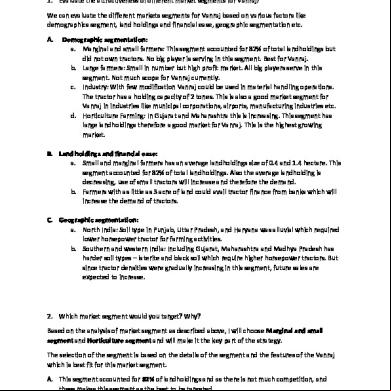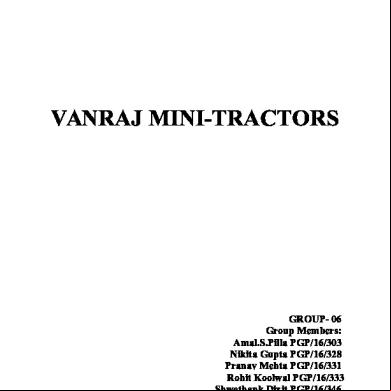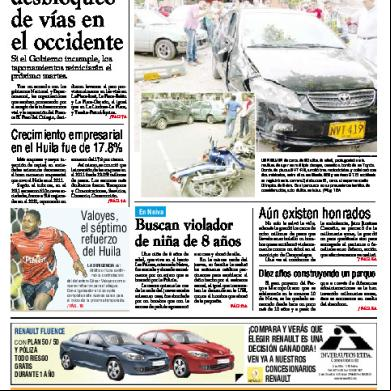Vanraj Mini Tractor-case Study(2) 1b2x5y
This document was ed by and they confirmed that they have the permission to share it. If you are author or own the copyright of this book, please report to us by using this report form. Report 3i3n4
Overview 26281t
& View Vanraj Mini Tractor-case Study(2) as PDF for free.
More details 6y5l6z
- Words: 1,059
- Pages: 5
Marketing Management Case Study
Vanraj Mini-Tractors
Group 5, Sec C Ankush Siddhu
135
Gaurav Gupta
145
Piyush Verma
155
Praneeth Kumar
165
Siva Kumar
175
Yeshwant Kumar
185
Issues: Identification of the most appropriate market segment for Vanraj Mini Tractors Objectives:
Analysing different market segments : Small and Marginal farmers; Horticulture farmers.
Selecting the most appropriate market segment for Vanraj tractors
To determine the break-even point for Vanraj tractors
Features of Vanraj Mini-Tractor:
Mini Tractor of 10 HP power
Performs all functions of big tractors at lower costs
Lesser Fuel Consumption
Better manoeuvrability and control in farming operations
First tractor with “Three-Wheel Convertible “ feature
First mini Tractor with tested Power Take-Off point
Demographic Segmentation Small Farmers and Marginal Farmers
Large Farmers
Large in number Small Landholdings (Avg 1.4- 0.4 hectares) Engaged in subsistence farming Uneconomical for farm mechanization
Small in number Large landholdings (Avg > 3 hectares) Engaged in commercial farming hence earning high income High levels of farm mechanization
Geographic Segmentation : Northern India (UP)
Soil is alluvial and fertile Require lower horsepower tractors Area under Horticultar farming: 1066 (‘000 hectares)
Southern and Western India (Gujarat, MP, Maharashtra) Harder soil-laterite and black soil Require higher horsepower tractors Area under Horticultar farming: 1550 (‘000 hectares)
Analysis: I) Calculation of Break Even Point Total Revenues = Fixed Cost + Total Variable Cost Assuming break even in 1st year itself (costs corresponding to 1st year only)
(at break even point)
1.9*S = (12.5 + 100) + (1.55*S) + [(S*1.2/300) + (S*0.6/300)] + (5.04 + 3.94 + 1.44 + 1.43 + 4.80) R
A
B
C
D
S = 380 Since sales are more than 300 (production in 1st year), we have to consider costs in 2nd year too. 1.9*S = (12.5 + 100) + (1.2 + 0.6) + (5.04 + 3.94 + 1.44 + 1.43 + 4.80) + (S-300)*(1.44+0.6)/330 + (6 + 4.32 + 1.8 + 1.36 + 4.56) C’ D’ Gives, S = 433 (Break Even Point) R: Revenue earned from tractor sales A: Paid up capital and cost of acquiring the technology B: Cost of raw material (variable cost) C: Cost of electricity and consumables (variable cost in 1st year) D: Cost of salary, overhead, sales expense, depreciation and interest paid (fixed cost in 1st year) C’: Cost of electricity and consumables (variable cost in 2nd year) D’: Cost of salary, overhead, sales expense, depreciation and interest paid (fixed cost in 2nd year) II) Analysis of Small and Marginal farmers sector In India, small farmers traditionally relied upon bullocks for all their agricultural needs. Therefore, the main competitor for Vanraj Mini tractor were bullocks rather than other Chinese make cheap tractors which were not suitable for Indian trying conditions. (i) Comparative Analysis: Average land holding of marginal farmers was 0.4 hectares and small farmers was 1.4 hectares. Hence, assuming that farmers in this segment would meet their farming requirements with a pair of bullocks, a comparative analysis is presented below : Initial cost Life span Other Costs
Maintenance costs Total cost incurred
(ii) Challenges:
Bullocks ( 2 ) Rs 0.027 m 8-9 years Fodder= Rs 17500*11yrs =Rs 192500
Vanraj Mini Rs 0.19 m 8-9 years Fuel= 950 hrs*1.5 l/hr *Rs 33/litre*8 =Rs 376200 Nil 15% of SP = Rs 0.03 million Rs 0.22 million for 8 Rs 0.6 million for 8 yrs usage yrs usage
Other small tractors Rs 0.16 m 6-7 years Fuel costs same as that of Vanraj 40% of SP= Rs 0.06 million Rs 0.6 million for 6 yrs usage
•
Though, using a mechanized equipment rather than bullocks would increase efficiency in agricultural methods, total cost incurred on Vanraj mini is 3 times more when compared with total cost incurred on bullocks. Hence, it is not economical for small farmers.
•
It is more economical for farmers to hire a big tractor. This way they would be saving time and work more efficiently.
III) Analysis of Horticulture Sector: (i) Advantages of Vanraj Mini tractor over others in horticulture sector : •
The big tractors are unwieldy in negotiating their way through the small gap between the lanes in horticulture farms. Vanraj’s small turning radius and mini-size would make it easy to maneuver it through the small lanes of horticulture farms.
•
The three-wheel convertibility option available in Vanraj would be of great use in interculture operations in Horticulture farms.
•
Savings on initial cost: Vanraj Mini tractor price= Rs 0.19 million Least price of a Big Tractor= Rs 0.24 million Savings= Rs 0.05 million
•
Savings on fuel Cost : Vanraj Mini Tractor consumption= 1.5 litre/hr Average consumption of a big tractor= 4 litre/hr Savings in fuel= 2.5 litre/hr Savings in fuel cost= 2.5 * 33 = Rs 82.5 /hr Hence, Horticulture sector would serve as a niche market for Vanraj Tractors.
(ii) Estimation of market potential in Horticulture segment : •
Percentage change in area from 1991-92 to 2001-02: Area under Fruits
Area under Vegetables
Maharashtra 127.56 66.9 Gujarat 76.33 102.6 Uttar Pradesh -4.9 34.88 Madhya Pradesh -27.99 -22.66 • Horticulture sector recorded very high growth in the period from 1991-92 to 2001-02 with 50% increase of land area under fruits and 39% increase of land area under vegetables. •
Total land under Horticulture in 2001-02= 2615.6 hectares
•
Owners of such farms are well off and they can afford Vanraj as their second tractor for their special needs where big tractors are unwieldy.
•
Hence, making a reasonable assumption that 1 tractor is required for every 2 hectares ( i.e approximately 5 acres ), then number of tractors required = 1308
•
Hence, estimated market potential in Horticulture = 1308 * 1.9 = Rs 24.85 crores
(iii) Recommendations: 1. Horticulture sector presents a niche market for Vanraj. It is concentrated only in few pockets of states. Hence, Vanraj marketing should focus on such areas to fully tap the market potential. 2. Area under Horticulture saw a decrease in states like Madhya Pradesh. Hence, Vanraj s.hould
interact with farmers in this region, find out the reasons and give them proper advice and hence should try to create a market for them. 3. Market of small and marginal farmers is not a viable option according to the cost-benefit analysis done above.
Vanraj Mini-Tractors
Group 5, Sec C Ankush Siddhu
135
Gaurav Gupta
145
Piyush Verma
155
Praneeth Kumar
165
Siva Kumar
175
Yeshwant Kumar
185
Issues: Identification of the most appropriate market segment for Vanraj Mini Tractors Objectives:
Analysing different market segments : Small and Marginal farmers; Horticulture farmers.
Selecting the most appropriate market segment for Vanraj tractors
To determine the break-even point for Vanraj tractors
Features of Vanraj Mini-Tractor:
Mini Tractor of 10 HP power
Performs all functions of big tractors at lower costs
Lesser Fuel Consumption
Better manoeuvrability and control in farming operations
First tractor with “Three-Wheel Convertible “ feature
First mini Tractor with tested Power Take-Off point
Demographic Segmentation Small Farmers and Marginal Farmers
Large Farmers
Large in number Small Landholdings (Avg 1.4- 0.4 hectares) Engaged in subsistence farming Uneconomical for farm mechanization
Small in number Large landholdings (Avg > 3 hectares) Engaged in commercial farming hence earning high income High levels of farm mechanization
Geographic Segmentation : Northern India (UP)
Soil is alluvial and fertile Require lower horsepower tractors Area under Horticultar farming: 1066 (‘000 hectares)
Southern and Western India (Gujarat, MP, Maharashtra) Harder soil-laterite and black soil Require higher horsepower tractors Area under Horticultar farming: 1550 (‘000 hectares)
Analysis: I) Calculation of Break Even Point Total Revenues = Fixed Cost + Total Variable Cost Assuming break even in 1st year itself (costs corresponding to 1st year only)
(at break even point)
1.9*S = (12.5 + 100) + (1.55*S) + [(S*1.2/300) + (S*0.6/300)] + (5.04 + 3.94 + 1.44 + 1.43 + 4.80) R
A
B
C
D
S = 380 Since sales are more than 300 (production in 1st year), we have to consider costs in 2nd year too. 1.9*S = (12.5 + 100) + (1.2 + 0.6) + (5.04 + 3.94 + 1.44 + 1.43 + 4.80) + (S-300)*(1.44+0.6)/330 + (6 + 4.32 + 1.8 + 1.36 + 4.56) C’ D’ Gives, S = 433 (Break Even Point) R: Revenue earned from tractor sales A: Paid up capital and cost of acquiring the technology B: Cost of raw material (variable cost) C: Cost of electricity and consumables (variable cost in 1st year) D: Cost of salary, overhead, sales expense, depreciation and interest paid (fixed cost in 1st year) C’: Cost of electricity and consumables (variable cost in 2nd year) D’: Cost of salary, overhead, sales expense, depreciation and interest paid (fixed cost in 2nd year) II) Analysis of Small and Marginal farmers sector In India, small farmers traditionally relied upon bullocks for all their agricultural needs. Therefore, the main competitor for Vanraj Mini tractor were bullocks rather than other Chinese make cheap tractors which were not suitable for Indian trying conditions. (i) Comparative Analysis: Average land holding of marginal farmers was 0.4 hectares and small farmers was 1.4 hectares. Hence, assuming that farmers in this segment would meet their farming requirements with a pair of bullocks, a comparative analysis is presented below : Initial cost Life span Other Costs
Maintenance costs Total cost incurred
(ii) Challenges:
Bullocks ( 2 ) Rs 0.027 m 8-9 years Fodder= Rs 17500*11yrs =Rs 192500
Vanraj Mini Rs 0.19 m 8-9 years Fuel= 950 hrs*1.5 l/hr *Rs 33/litre*8 =Rs 376200 Nil 15% of SP = Rs 0.03 million Rs 0.22 million for 8 Rs 0.6 million for 8 yrs usage yrs usage
Other small tractors Rs 0.16 m 6-7 years Fuel costs same as that of Vanraj 40% of SP= Rs 0.06 million Rs 0.6 million for 6 yrs usage
•
Though, using a mechanized equipment rather than bullocks would increase efficiency in agricultural methods, total cost incurred on Vanraj mini is 3 times more when compared with total cost incurred on bullocks. Hence, it is not economical for small farmers.
•
It is more economical for farmers to hire a big tractor. This way they would be saving time and work more efficiently.
III) Analysis of Horticulture Sector: (i) Advantages of Vanraj Mini tractor over others in horticulture sector : •
The big tractors are unwieldy in negotiating their way through the small gap between the lanes in horticulture farms. Vanraj’s small turning radius and mini-size would make it easy to maneuver it through the small lanes of horticulture farms.
•
The three-wheel convertibility option available in Vanraj would be of great use in interculture operations in Horticulture farms.
•
Savings on initial cost: Vanraj Mini tractor price= Rs 0.19 million Least price of a Big Tractor= Rs 0.24 million Savings= Rs 0.05 million
•
Savings on fuel Cost : Vanraj Mini Tractor consumption= 1.5 litre/hr Average consumption of a big tractor= 4 litre/hr Savings in fuel= 2.5 litre/hr Savings in fuel cost= 2.5 * 33 = Rs 82.5 /hr Hence, Horticulture sector would serve as a niche market for Vanraj Tractors.
(ii) Estimation of market potential in Horticulture segment : •
Percentage change in area from 1991-92 to 2001-02: Area under Fruits
Area under Vegetables
Maharashtra 127.56 66.9 Gujarat 76.33 102.6 Uttar Pradesh -4.9 34.88 Madhya Pradesh -27.99 -22.66 • Horticulture sector recorded very high growth in the period from 1991-92 to 2001-02 with 50% increase of land area under fruits and 39% increase of land area under vegetables. •
Total land under Horticulture in 2001-02= 2615.6 hectares
•
Owners of such farms are well off and they can afford Vanraj as their second tractor for their special needs where big tractors are unwieldy.
•
Hence, making a reasonable assumption that 1 tractor is required for every 2 hectares ( i.e approximately 5 acres ), then number of tractors required = 1308
•
Hence, estimated market potential in Horticulture = 1308 * 1.9 = Rs 24.85 crores
(iii) Recommendations: 1. Horticulture sector presents a niche market for Vanraj. It is concentrated only in few pockets of states. Hence, Vanraj marketing should focus on such areas to fully tap the market potential. 2. Area under Horticulture saw a decrease in states like Madhya Pradesh. Hence, Vanraj s.hould
interact with farmers in this region, find out the reasons and give them proper advice and hence should try to create a market for them. 3. Market of small and marginal farmers is not a viable option according to the cost-benefit analysis done above.





